Do you have a question about the ADEMCO VISTA-128FBP and is the answer not in the manual?
Introduction to ADEMCO Partitioned Security System, its protection types, and components.
Explains shared system use among users, panel networking, and zones.
Covers fire/burglary protection, alarm behavior, and memory of alarm.
Details Speed Keys, Schedules, Device Timers, Partition Access, Keypads, Self-Help, and Phone Access.
Describes general keypad functions, display, sounder, and lighting.
Details the Alpha Keypad's 2-line LCD, user-friendly messages, and custom descriptors.
Explains function keys, display, and LEDs (ARMED, READY, TROUBLE, SUPER).
Details operations of keys 1-9, *, and # for arming, disarming, and system functions.
Explains the meaning of LED indicators and the keypad speaker's role.
Explains installer-programmed exit and entry delays for arming and disarming.
Covers assigning security codes and authority levels to users for system access.
Explains the duress code for silent notification to the central station.
Describes the shortcut to arm the system using the # key.
Details the six different authority levels and their associated system capabilities.
Outlines rules for adding, changing, or deleting user codes and authority levels.
Step-by-step guide for programming new users, changing codes, and deleting users.
How to use the GOTO command to switch control between system partitions.
Allows users to arm or disarm multiple partitions simultaneously.
Explains Single-Partition, Multi-Partition, and Multi-Panel View modes for accessing linked panels.
Describes accessing and controlling a single partition on a remote panel.
Covers accessing and controlling multiple partitions across linked panels simultaneously.
Details viewing status and controlling multiple remote panels at once.
Shows the priority of displayed conditions when multiple events occur in panel linking modes.
How to check for open or faulted zones before arming the system.
How to display all programmed zone descriptions using the READY key.
How to intentionally exclude specific zones from protection when arming.
Allows bypassing all open zones simultaneously without individual entry.
How to view which zones have been previously bypassed.
Allows bypassing pre-defined groups of zones.
Arming the system for perimeter protection while allowing movement inside.
Automatically bypasses zones if no entry/exit points are faulted during exit delay.
Arming perimeter protection with immediate alarm on zone opening, no entry delay.
Arms both perimeter and interior protection for when no one is present.
Arms all protection for extended vacancies, with no entry delay.
Allows exiting an armed partition without disarming and rearming.
Procedure to disarm the system and silence audible alarms and troubles.
Explains arming and disarming a partition using the system's keyswitch.
Activates chime mode to alert on door/window openings when disarmed.
How users receive and view messages from the monitoring agency or installer.
Describes using key combinations for Silent, Audible, Personal, or Fire emergencies.
How to program custom command sequences (macros) for A, B, C, D keys.
How to activate programmed Speed Key sequences.
Using Speed Keys to silence fire alarms or navigate fire events.
Details keypad commands for unlocking access doors for specific durations.
How to use the #70 command to turn devices (lights, appliances) on or off.
How master/manager users can delay automatic arming time by up to 2 hours.
How to override normal schedules with temporary ones for up to a week.
Step-by-step guide for setting up temporary daily arming/disarming windows.
Explains device timers for ON/OFF times and selected days, up to 20 timers.
How to initiate random schedules for devices to simulate occupancy.
Lists action codes for relays, arming, disarming, and bypasses with specifiers.
Details action codes for auto-bypassing and auto-unbypassing zones.
Covers enabling windows for opening/closing and access control commands.
Explains additional commands and how to enter the Instant Activation Mode.
How to access and view system events, specifying RECENT or COMPLETE logs and partitions.
Lists and describes different event categories like ALARM, CHECK, BYPASS, OPEN, SYSTEM, ALL.
Puts the system into Test mode to check protection point operation.
Step-by-step guide to test doors, windows, motion detectors, and smoke detectors.
Actions to take if a fire is detected or suspected before detectors activate.
Procedure to silence fire alarms and clear the display after a fire event.
Feature to lock keypad display on the first alarm zone, with methods to view others.
How to conduct a fire drill test to activate notification circuits.
Explains common trouble messages like CHECK, TRBL, CALL SERVICE, and zone-specific faults.
Covers COMM. FAILURE, SYSTEM LO BAT, MODEM COMM, HSENS, LSENS, and Power Failure.
Recommends establishing and practicing escape plans for fire emergencies.
General advice on system testing and maintenance for reliable operation.
Guide on detecting and replacing low batteries in wireless sensors and keypads.
How to silence low battery warning tones at the keypad.
Instructions for cleaning and handling system components to prevent damage.
A quick reference table for common system functions, procedures, and comments.
Explains sounds, causes, and display messages for various system alerts and warnings.
Information regarding Canadian certification, installation, and user responsibilities.
Introduction to ADEMCO Partitioned Security System, its protection types, and components.
Explains shared system use among users, panel networking, and zones.
Covers fire/burglary protection, alarm behavior, and memory of alarm.
Details Speed Keys, Schedules, Device Timers, Partition Access, Keypads, Self-Help, and Phone Access.
Describes general keypad functions, display, sounder, and lighting.
Details the Alpha Keypad's 2-line LCD, user-friendly messages, and custom descriptors.
Explains function keys, display, and LEDs (ARMED, READY, TROUBLE, SUPER).
Details operations of keys 1-9, *, and # for arming, disarming, and system functions.
Explains the meaning of LED indicators and the keypad speaker's role.
Explains installer-programmed exit and entry delays for arming and disarming.
Covers assigning security codes and authority levels to users for system access.
Explains the duress code for silent notification to the central station.
Describes the shortcut to arm the system using the # key.
Details the six different authority levels and their associated system capabilities.
Outlines rules for adding, changing, or deleting user codes and authority levels.
Step-by-step guide for programming new users, changing codes, and deleting users.
How to use the GOTO command to switch control between system partitions.
Allows users to arm or disarm multiple partitions simultaneously.
Explains Single-Partition, Multi-Partition, and Multi-Panel View modes for accessing linked panels.
Describes accessing and controlling a single partition on a remote panel.
Covers accessing and controlling multiple partitions across linked panels simultaneously.
Details viewing status and controlling multiple remote panels at once.
Shows the priority of displayed conditions when multiple events occur in panel linking modes.
How to check for open or faulted zones before arming the system.
How to display all programmed zone descriptions using the READY key.
How to intentionally exclude specific zones from protection when arming.
Allows bypassing all open zones simultaneously without individual entry.
How to view which zones have been previously bypassed.
Allows bypassing pre-defined groups of zones.
Arming the system for perimeter protection while allowing movement inside.
Automatically bypasses zones if no entry/exit points are faulted during exit delay.
Arming perimeter protection with immediate alarm on zone opening, no entry delay.
Arms both perimeter and interior protection for when no one is present.
Arms all protection for extended vacancies, with no entry delay.
Allows exiting an armed partition without disarming and rearming.
Procedure to disarm the system and silence audible alarms and troubles.
Explains arming and disarming a partition using the system's keyswitch.
Activates chime mode to alert on door/window openings when disarmed.
How users receive and view messages from the monitoring agency or installer.
Describes using key combinations for Silent, Audible, Personal, or Fire emergencies.
How to program custom command sequences (macros) for A, B, C, D keys.
How to activate programmed Speed Key sequences.
Using Speed Keys to silence fire alarms or navigate fire events.
Details keypad commands for unlocking access doors for specific durations.
How to use the #70 command to turn devices (lights, appliances) on or off.
How master/manager users can delay automatic arming time by up to 2 hours.
How to override normal schedules with temporary ones for up to a week.
Step-by-step guide for setting up temporary daily arming/disarming windows.
Explains device timers for ON/OFF times and selected days, up to 20 timers.
How to initiate random schedules for devices to simulate occupancy.
Lists action codes for relays, arming, disarming, and bypasses with specifiers.
Details action codes for auto-bypassing and auto-unbypassing zones.
Covers enabling windows for opening/closing and access control commands.
Explains additional commands and how to enter the Instant Activation Mode.
How to access and view system events, specifying RECENT or COMPLETE logs and partitions.
Lists and describes different event categories like ALARM, CHECK, BYPASS, OPEN, SYSTEM, ALL.
Puts the system into Test mode to check protection point operation.
Step-by-step guide to test doors, windows, motion detectors, and smoke detectors.
Actions to take if a fire is detected or suspected before detectors activate.
Procedure to silence fire alarms and clear the display after a fire event.
Feature to lock keypad display on the first alarm zone, with methods to view others.
How to conduct a fire drill test to activate notification circuits.
Explains common trouble messages like CHECK, TRBL, CALL SERVICE, and zone-specific faults.
Covers COMM. FAILURE, SYSTEM LO BAT, MODEM COMM, HSENS, LSENS, and Power Failure.
Recommends establishing and practicing escape plans for fire emergencies.
General advice on system testing and maintenance for reliable operation.
Guide on detecting and replacing low batteries in wireless sensors and keypads.
How to silence low battery warning tones at the keypad.
Instructions for cleaning and handling system components to prevent damage.
A quick reference table for common system functions, procedures, and comments.
Explains sounds, causes, and display messages for various system alerts and warnings.
Information regarding Canadian certification, installation, and user responsibilities.
| Zones | 128 |
|---|---|
| Partitions | 8 |
| User Codes | 150 |
| Event Log | 512 events |
| Keypads Supported | Up to 16 |
| Power Supply | 16.5VAC, 40VA transformer |
| Type | Hybrid (hardwired and wireless) |
| Communication | Phone Line, Cellular, IP |
| Backup Battery | 12VDC, 7AH |
| Outputs | 2 on-board relays, up to 96 outputs with expansion |
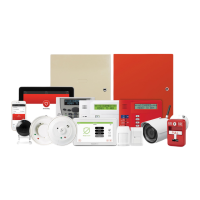
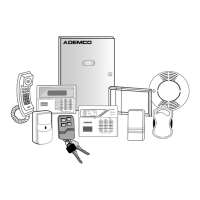
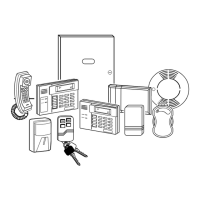
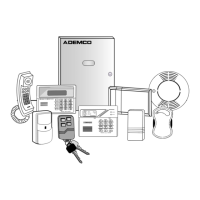


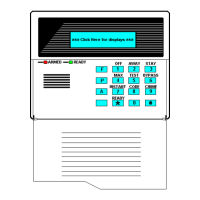




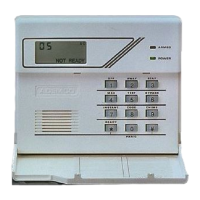
